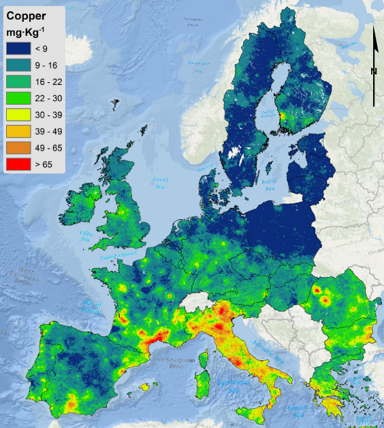> Planet
Which soils have the highest copper concentration?
There are natural differences between soils in background copper concentration following climatic, geological and pedological factors. In addition, anthropogenic (related to the influence of human beings on nature) effect is the long-term consequence of economic activities. The spraying of copper since decades as a fungicide on vineyards created hot spots of soil accumulation.
In 2014, a European project performed a realistic risk assessment of trace elements in more than 4000 soil samples. For copper, only a few, isolated sites were predicted at risk : 1,6% and 1,3% of sites for agricultural and grazing land, respectively.
Environmental risk assessment (ERA) is required for any substances that enter the environmental compartments. To assess the exposure, the concentrations of each substance in each environmental compartment are estimated. Therefore, predicted environmental concentrations (PECs) are calculated for soil, surface water, groundwater and sediment. Potential toxicity is estimated using laboratory and/or field studies combined with relevant safety factors to determine the predicted no-effect concentrations (PNECs) that Cu poses to soil, aquatic and sediment dwelling organisms.
The risk is then calculated by comparing the calculated exposure (PECs) to the hazard (PNECs) for each environmental compartment.

If the ratio of PEC/PNEC is above 1, the substance poses a risk to the environment and is considered unacceptable unless further refinements are proposed, or new studies are performed.
In 2018, a more ambitious survey, with 1 site/200 km2 sampling density, used 21 682 soil samples to investigate copper distribution in the soils of 25 European Union (EU) Member States. The combined effect of soil properties such as high pH, soil organic carbon and clay, with humid and wet climatic conditions favours copper accumulation in soils of vineyards and tree crops. Compared to the overall average Cu concentration of 16,9 mg/kg, vineyards had the highest mean soil Cu concentration (49,3 mg/kg) of all land use categories, followed by olive groves and orchards.


